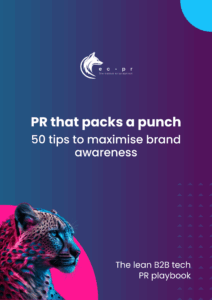
How to write a powerful B2B case study
Case studies are an invaluable asset in the marketing armoury and you need to know how to write one that educates, influences and persuades – writing that packs a punch!
Start by deciding what type of case study you need. This article focuses on writing B2B business case studies, including both editorial and sales case studies. We also feature an essential B2B template for inspiring case study questions.
Writing a B2B case study FAQ
- What are the key characteristics of an editorial case study?
- What is the purpose of an editorial case study?
- Where do editorial case studies appear?
- What are the key characteristics of a sales case study?
- What’s the objective of a sales case study?
- Where do sales case studies appear?
- How to write your own case studies
- Your essential B2B case study template
- Your B2B case study checklist
1 What are the key characteristics of an editorial case study?
Editorial case studies tend to be longer – they act as a storytelling device, with a narrative structure of 800-1200 words. They are detail-oriented, focusing on the whole customer journey and perspective of the problem, range of solutions available, decision-making rationale and subsequently, the business impact of the solution they selected.
Objectively written, and more authoritative in nature, editorial case studies, can carry more information about the business and its area of expertise. This is not dissimilar to the elements you might find within a thought leadership strategy that shows a company or a spokesperson as an authority figure in the industry, giving articulate, informed and engaging opinions on crucial topics.
2 What is the purpose of an editorial case study?
Editorial case studies help to build credibility through endorsement and create brand awareness but should not be promotional. They will have most appeal to people already in the buying cycle. They offer up an excellent opportunity for prospects to engage with an independent view of a real-life example of how your company has benefitted a customer. In fact, the best editorial case studies will feature extensive direct contributions and comments from specific customers who are happy with your services.
If a customer has increased revenue or been able to grow, the results speak for themselves, without having to actively ‘sell’ anything. It’s a great way to publicise the value of the products and services you offer and create familiarity. Editorial case studies are designed to educate and inform.
3 Where do editorial case studies appear?
An editorial case study falls into the category of ‘earned media’ and will appear in third-party channels such as magazines and websites. The publications that pick this up will focus on issues from a reader perspective and therefore have an interest in how customers are addressing common challenges. Editorial case studies, written by an expert writer, or journalist, are perfect collateral for these kinds of publication, as they are solution-oriented rather than sales focused.
The overall tone is considered and credible, leaving the reader confident that your business has the solution they’re looking for because of what respected third parties have chosen to say about you.
4 What are the key characteristics of a sales case study?
One of the most evident differences between a sales case study and an editorial case study is the length and structure. Sales case studies are considerably shorter at only 450-600 words and are usually much more succinct. For that reason, companies opt for snappier sentences, with more adjectives, and bullet points to get their message across in as few words as possible. This helps to spark interest and draw the reader in. Sales case studies are written from the perspective of the company and tend to focus on the specific features and benefits that your company, alone, can provide underpinned by great customer quotes.
5 What’s the objective of a sales case study?
The purpose of a sales case study is to highlight the reliability of a product or service in delivering on its customer promise (aka value proposition) and the excellent customer experience delivered.
Rather than objective, these case studies are partisan, they are passionate advocacy pieces rooted in fact but designed to do one thing – reassure and entice. They make an excellent business case that entices buyers and prospective customers into stepping into the sales funnel.
Where do sales case studies appear?
A sales case study can appear in a variety of forms in any media over which you have complete control, known as owned media. This includes channels such as your website, LinkedIn, X (Twitter), sales presentations, and company brochures. A sales case study would never appear in high quality third-party media – unless as an advertorial – which immediately reduces its credibility. The overall tone of a sales case study is persuasive and provocative. It serves to convince a customer of a company’s benefits and inspire interest in products and services. It should aim to answer some of the most pressing questions first and then explain how you will help them do business better.
How to write your own case studies
If you’re looking for ways to grow your customer base and create new leads, case studies are an excellent tool. You don’t always have to pick between editorial or sales either. Both can be leveraged side by side to appeal to different customer segments, create stronger brand awareness and coax more leads into your sales funnel. Read on and use our template to write effective B2B case studies.
8 Your essential B2B case study template
Hidden item
How to set the context with challenges and goals
Setting the context starts with describing the situation before you came into your customers life and describing the needs and goals that your customer hoped would be achieved. Questions to ask:
- What specific challenge were you looking to solve or what goal were you trying to achieve?
- [If a challenge] What could have happened if you hadn’t resolved this challenge?
- Had you already tried other solutions that didn’t work? If so, what happened?
- Which of the following objectives would you say solving this challenge OR achieving this goal would support?
- Complying with government
- Lowering business costs
- Becoming profitable
- Generating more leads
- Closing more deals
- Generating more revenue
- Expanding into a new market
- Becoming more sustainable or energy-efficient
- Other (please detail)
How and why you won the business
People are always interested in the process that delivered a strong partnership, they want to know how and why they can replicate it for themselves. Questions to ask:
- How did you hear about/know of our company/brand?
- Can you describe what made our brand stand out from its competitors?
- Who was involved in the decision making and where are they based?
- Can you tell us more about the decision-making process you went through?
- What were the most important factors when considering potential options?
How to showcase the success of your project or partnership
The purpose of a case study should be to clearly describe what has changed and what is better after a project has been completed or activated. Questions to ask:
- How long did it take to get the solution/support up and running?
- Did the timescale meet your expectations?
- Who was involved in that process and where are they based?
- How has your business benefited from working with us?
- Is there a particular benefit of working with our brand that you rely on/value the most?
- How is the relationship helping you increase productivity/efficiency and/or save time/money?
- How does this give you more competitive edge?
- Looking forward, what are your plans for the future and how might these involve continued collaboration with us?
- Can you give an example of a particular issue that we/our brand has helped you overcome and explain how?
How to develop a meaningful testimonial
A meaningful testimonial is one that says something other than ‘we think they are great’ which tells no one anything that they can learn from. A case study should educate, influence, and persuade. The testimonial should be designed to deliver the persuasion. Questions to ask:
- Are you happy to provide a testimonial about your work with us/our brand?
- Who would be best placed to draft this?
- When might we expect it?
9 Your B2B case study checklist
Editorial case study:
Focus on the customer’s perspective and their view of the problem
This is Solution message oriented
Appears in 3rd party channels, it appears in earned media e.g., a magazine
Tone: considered and credible
What’s its value to you? Endorsement, positioning, expertise
Trust level: High
Sales case study:
Bullets permitted
More adjectives
Subjective/partisan
Written from your perspective
This is Value message oriented
Appears on your website/sales collateral, it appears in owned media e.g., your website
Tone: persuasive and passionate
What’s its value to you? Education, evidence
Trust level: Low

THE HACK B2B PR: Write Press Releases That Get Published
Our expert B2B PR guide to creating a press release that editors want to publish.
Subscribe to our updates
Stay up to date with the latest insights, case studies and PR guides.



